Digital Sustainability: How to Get Started Today
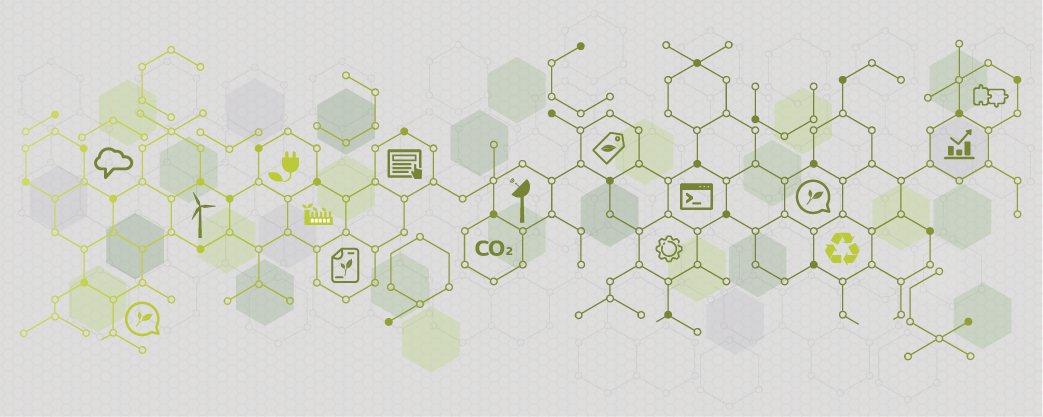
Confused about how your organization can embrace and operationalize digital sustainability? In this post, we share common principles and a roadmap to get you started today.
What is Digital Sustainability?
Digital sustainability harnesses the tools of digital transformation, such as enhanced connectivity and the Internet of Things (IoT), to improve the environment and support sustainable business operations. But with the internet accounting for around 3.7% of global greenhouse gas emissions it can be a tricky circle to square.
— Bettina Tratz-Ryan, What is Digital Sustainability and How Can it Support ESG Goals?
According to academic research, the definition of digital sustainability has evolved from the preservation and maintenance of digital content (2007) to how an organization uses technology to advance sustainable development goals (2020). Here’s our take:
Digital sustainability is the process of applying social, economic, and environmental stewardship principles to digital products, services, and data delivered via the internet.
Designers and developers might interpret this as a call to deliver more resource-efficient digital products, and they would be right. However, it goes both ways: digital products and services can be used to advance sustainability efforts as well, per the quote above.
In this post, we share basic concepts, explore myths and misconceptions, and outline practices that anyone can adopt today to devise a clear climate strategy and achieve measurable digital sustainability outcomes.
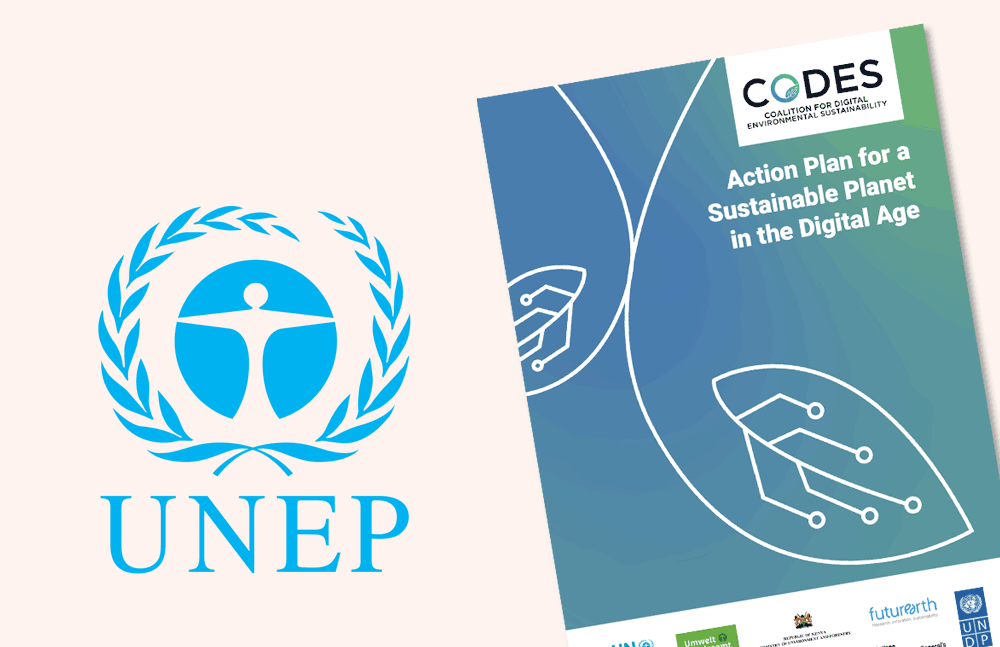
Enabling Global Digital Sustainability
Digital transformation is globally pervasive, increasing productivity, disrupting pre-existing business models and leading to diverse innovations with profound implications for the human future. This transformation has enormous potential to support progress towards sustainability. However in its current form, it continues to enable and/or encourage unsustainable practices that are degrading natural systems, entrenching inequality and undermining human wellbeing.
— U.N. Environment Programme, CODES Action Plan
The U.N. Environment Programme’s CODES Action Plan, quoted above, was authored by over 1,000 contributors from around the world (including Mightybytes). It was released at the 50th anniversary of the Stockholm Conference on the Human Environment. This plan represents the most comprehensive effort to date to explore intersectionality between digital technology and sustainability.
The plan calls for three fundamental systemic shifts to implement sustainable digital transformation:
- Enable Alignment: Align digital technology and sustainability with a common purpose by developing standards, training, and fostering cross-sector action.
- Mitigate Negative Impacts: Commit to “sustainable digitalization” that mitigates the negative social and environmental impacts of digital technologies such as emissions, e-waste, and the digital divide.
- Accelerate Innovation: Accelerate digital innovation for sustainability through labs, workshops, circular economy principles, and prioritizing a just transition.
According to the plan, accomplishing these shifts can help transform society and business models to a more sustainable and equitable world. The action items shared below all fall under at least one of these categories.
This short YouTube video quickly explains the action plan and why these three shifts are critical to a more sustainable digital future.
This approach makes sense if you’re the United Nations or another globally-focused organization whose mission is to make a difference in the world. However, what if you’re a small or mid-sized business or nonprofit? Can you make a difference, too?
Absolutely. Let’s explore how.
Enabling Digital Sustainability Within Your Organization
Practitioners should focus on investing behind organisational resources and technologies that enhance the operationalisation of digital sustainability rather than seeking to promote the understanding of the concept and importance of digital sustainability.
— The Hong Kong Polytechnic University, Digital Sustainability in the Organization: Scale Development and Validation
Your organization may not operate on a global scale. Similarly, you might not focus on emerging technologies, innovation labs, standards development, or a host of other things related to the three shifts mentioned above. However, your organization probably does own, manage, or use multiple digital products and services, such as:
- IT, DevOps, WebOps, etc.: Hosting, networks, and other digital infrastructure
- Marketing & Communications: Websites, mobile apps, social media, ads, email, and related platforms
- HR, Sales, Finance, & Operations: Licensed software and subscription services for data management
While you can only influence third-party providers so much, you do have control over internal decision-making related to many of the products and services listed above. This includes the tools you purchase and those you choose to partner with.
We recommend starting there.
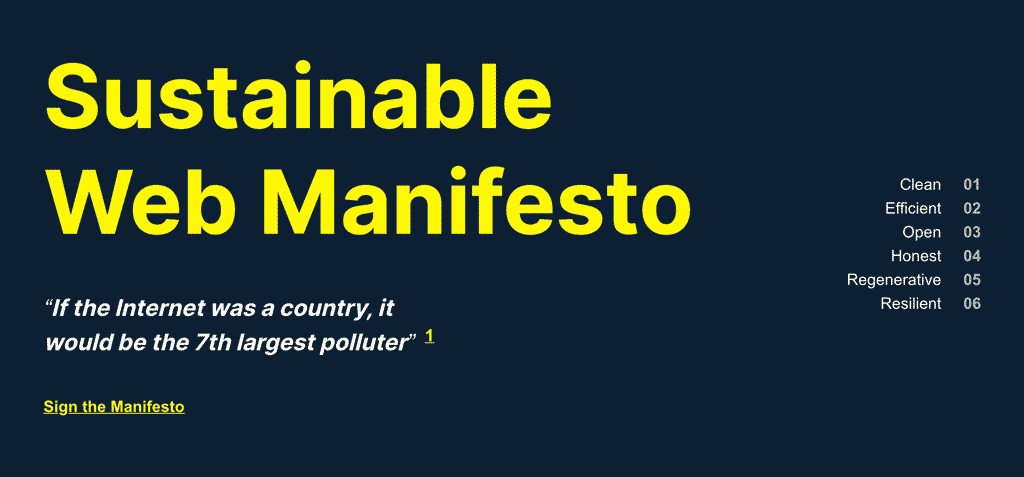
Digital Sustainability Principles: What to Do Today
In the face of the epic challenge of responding to the climate emergency, success will depend on every single one of us taking individual action and collaborating with those around us to have a real impact that’s bigger than the sum of our individual parts. We all have a role to play, and together we can create a web that serves the needs of society for generations to come.
— Tom Greenwood, Sustainable Web Design
To outline specific actions you can take today, let’s reference a more focused set of guidelines.
The Sustainable Web Manifesto was spearheaded by fellow B Corp agency Wholegrain Digital in 2019. Like the CODES Action Plan, it also included contributions from experts around the world, in this case specific to the web industry.
The manifesto states that a more sustainable internet follows these principles:
- Clean: Services provided will be powered by renewable energy.
- Efficient: Products and services will use the least amount of energy and material resources possible.
- Open: Internet-enabled products and services will be accessible, allow for the open exchange of information, and allow users to control their data.
- Honest: Websites, mobile applications, social networks, and other digital products and services will not mislead or exploit users.
- Regenerative: The internet will support an economy that nourishes people and the planet.
- Resilient: Digital products and services will function in the times and places where people need them most.
Anyone can sign the manifesto. Add your signature to thousands of others to support this vision of an internet we all need.
Many of these principles also overlap with the seven principles of corporate digital responsibility. In the points below, we’ve outlined how you can take tangible action on each.
1. Commit to Renewable Energy
When it comes to climate, speed is justice, so in the context of our work, instead of talking about a sustainable internet, we think it’s important to talk about just and sustainable internet. To do that, you need to be able to talk about power, not just energy.
— Chris Adams, The Green Web Foundation, Who Pays for Cleaner Energy on the Web?
Manifesto Principle: Services provided will be powered by renewable energy.
Fossil fuels play a significant role in the internet’s massive environmental impact. Digital products/services—and the systems that enable them—require electricity 100% of the time.
To mitigate the worst impacts of the climate emergency, all sectors and industries must transition to renewable energy as quickly as possible. For individual organizations, one of the most impactful things you can do is power your digital infrastructure with renewable energy. Often, this means switching to a green web host, which isn’t always as easy as it may seem.
However, not all renewable energy is created equal. Carbon offsets, Renewable Energy Credits (RECs), Power Purchase Agreements (PPAs), and other schemes complicate an already confusing energy landscape. Plus, fossil fuel companies aren’t helping these efforts. Also, digital infrastructure and green energy projects can fuel injustice.
Finally, it is widely accepted that organizations must adopt an emissions reduction strategy before relying on offsets, RECs, etc. Climate justice—especially as it relates to the internet— is a complex topic.
Take Action Today on Renewable Energy
Explore these resources to decipher how best to power your digital infrastructure with renewable energy:
- The Green Hosting Directory: Find a web host that powers their servers with renewable energy in this green hosting directory from The Green Web Foundation.
- RECs vs. PPAs vs. Offsets: Get up to speed on different renewable energy purchase options in this post from the Carbon Offset Guide.
- Ember: Better understand electricity demand, generation, capacity, and CO2 data for your region with Ember’s Data Explorer.
- Calculating Digital Emissions: Learn common formulas used to calculate and track digital emissions.
- Cloud Carbon Footprint: This free, open source tool can help you better understand the climate impacts of common cloud-based hosts, such as Google Cloud, AWS, and Azure.
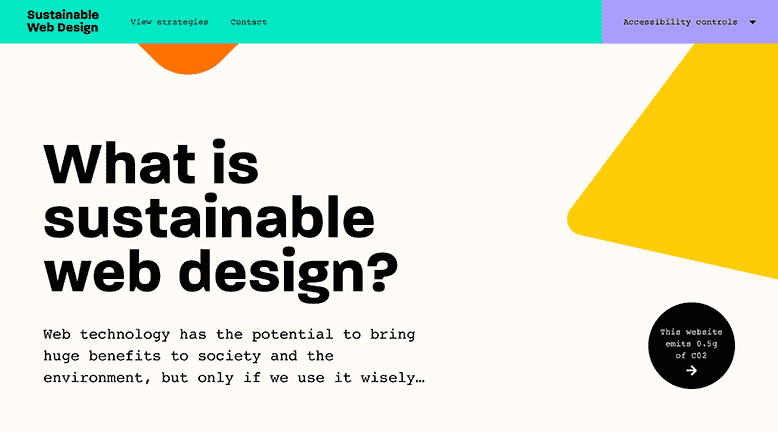
2. Improve Performance & Efficiency
Our web applications continue to grow in their scope, ambition, and functionality—that’s a good thing. However, the amount of data downloaded by each application continues to increase at a steady pace. To deliver great performance we need to optimize delivery of each and every byte!
— Ilya Grigorik, Google
Manifesto Principle: Products and services will use the least amount of energy and material resources possible.
For many organizations, this principle might be the most tangible path for you to make progress on digital sustainability. Performance optimization is inherent to all sustainability frameworks. Efficiency and performance are also key components of any emissions reduction strategy.
When it comes to the internet, this takes the form of optimizing digital assets and understanding the impact of their entire lifecycle:
- Reducing web page size
- Improving page performance and responsiveness
- Breaking down barriers to information access
- Streamlining user experience
- Maintaining efficiency over time
- And so on . . .
As noted above, reduce first, then offset what you can’t reduce. However, it is important to keep in mind that improved efficiency can also lead to rebound effects in the form of increased adoption and use.
Take Action Today on Performance & Efficiency
Use these resources to improve the efficiency of your digital products and services.
- Sustainable Web Design: This free online guide provides tagged and searchable access to the Web Sustainability Guidelines, which are on the path to define environmental standards for the web.
- Performance Calculators: Set a page weight budget to keep you on track when conceptualizing new landing pages. Start with PerformanceBudget.io.
- Performance Audits: There are many free audit tools available to help you improve performance, including our web sustainability tool Ecograder, Pingdom Tools, Speedcurve, and others.

3. Improve Access to Information
Allies to the disabled environmentalist community should help advocate for accessible sustainable practices and materials that are considerate of disabled needs. When holding panels, writing legislation, building sustainable programs, and creating materials that are helpful to the environment, it is very important that the disabled community is not only advocated for but also represented.
— Ambika Rajyagor, cofounder of Disabled & Outdoors, from The Intersectional Environmentalist
Manifesto Principle: Internet-enabled products and services will be accessible, allow for the open exchange of information, and allow users to control their data.
Lack of access to information can be life-threatening in some scenarios. Similarly, personal data in the wrong hands can have damaging effects on people’s health, well-being, and financial security.
Organizations should prioritize accessibility and give stakeholders ownership of their data. Similarly, the open exchange of information can vastly improve digital products and services. WordPress—an open source tool that powers over 40% of the internet and 62% of all CMS-driven websites (including this one)—is a great example of this.
Take Action Today to Improve Access to Information
Here are some actions to consider taking to improve accessibility, data ownership, and so on.
- Intersectionality: Read this post on the intersectionality between digital accessibility and web sustainability to understand foundational topics.
- Accessibility Audit: Use a free tool like SiteImprove or WebAIM’s Wave to see how accessible your content is. Just keep in mind that automated checkers only flag about one-third of all potential accessibility issues on a page.
- Data Privacy Checklist: Use this data privacy checklist to ensure that your organization respects data privacy and ownership in its digital communications.
- Open Source: Read the Open Source Way to understand how open information exchanges can positively change our world.
4. Fight Mis/disinformation
In their relentless pursuit of engagement and profits, these platforms created algorithms that amplify hate speech, disinformation, and conspiracy theories. This harmful content is particularly engaging and serves as the lubricant for businesses as profitable as they are influential. These platforms also enforce their terms of service in ways that favor extreme speech and behavior, predominantly right-wing extremism.
— Roger McNamee, Platforms Must Pay for Their Role in the Insurrection
Manifesto Principle: Websites, mobile applications, social networks, and other digital products and services will not mislead or exploit users.
Mis/disinformation, surveillance capitalism, “dark patterns”, the list of dishonest or downright nefarious internet practices is long. However, the rampant spread of misinformation and disinformation through online channels is at the top of this list.
Take Action Today on Mis/disinformation
Use these resources to align your digital marketing and communications strategies with ethical, responsible practices.
- Code of Ethics: Clearly document the ethical guidelines your organization uses to conduct business. Feel free to use our Code of Ethics as a template for your own.
- Ethical Marketing Policy: Prioritize truth telling and honesty in your marketing communications with this Ethical Marketing Policy template from fellow B Corp JB Media Group (Google Doc).
- Social Digital Responsibility: Read this post on the social aspects of digital responsibility to learn how you can combat fake news, protect privacy, promote honesty and truth-telling, and effectively moderate content across channels.
- Strategic Partnerships: Find ethical partners to form strategic alliances that can help you quickly fill gaps in your skills or capacity. This post on finding an ethical agency partner can help you figure out what to look for.
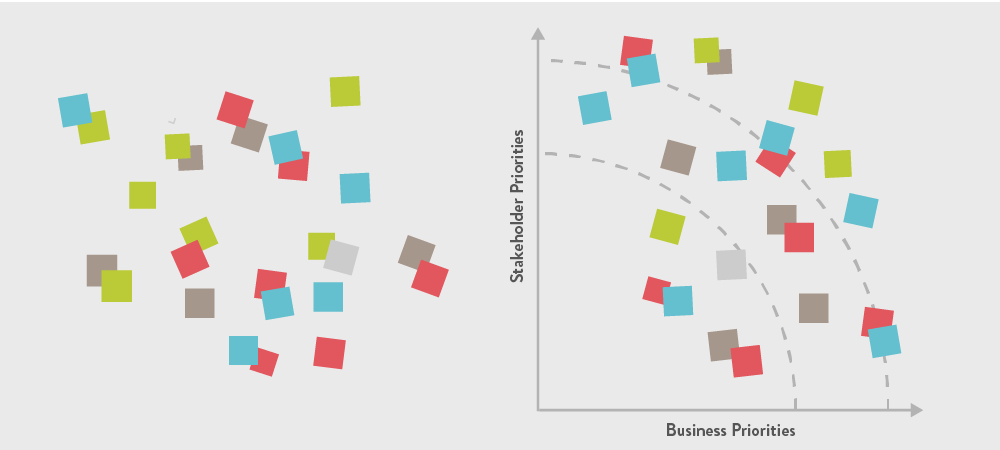
5. Support Regeneration and the Impact Economy
Acting with digital responsibility requires that the organization is not only aware of the various potential effects of the digital on consumers and society but also concerned for how its own actions may prompt such effects. Accordingly, CDR culture must establish that designers and creators of the technology bear responsibility for consequences that arise from its creation, operation, impact assessment, and refinement.
— Corporate Digital Responsibility, Journal of Business Research, Elsevier
Manifesto Principle: The internet will support an economy that nourishes people and the planet.
Digital products and services can help us get beyond the “extract and exploit” practices of traditional capitalism to support an economy that nourishes all people and our shared planet. However, to accomplish this, organizations must establish digital-specific standards of practice for better serving organizational stakeholders, not just shareholders.
Take Action Today to Support the Impact Economy
Use these tools to help your organization better support the impact economy.
- Stakeholder Mapping: This guide for purpose-driven organizations uses a human-centered design workshop format to help you better understand your business ecosystem and the stakeholders who populate it.
- Marketing Practices: Read these two posts on how to redefine success in marketing and align your digital marketing strategy with an impactful climate strategy.
- Impact Business Models (IBMs): Use this handy IBM guide or the B Impact Assessment to fold positive social and environmental impact into your business operations.
- Design Sprint: While you may not be able to run a design sprint today, we included it in our list because these engagements can help organizations quickly create alignment on how to solve big problems. Read up on the process in this Alliance for the Great Lakes case study.
- Choice Architecture: Finally, how might your digital products and services ethically promote more sustainable behaviors in users? Analyze common user interface elements, like forms and checkout processes, for opportunities to reduce packaging, support low-emissions shipping, and so on. The Sustainable Ecommerce Handbook from the Ecomm Manager is filled with suggestions.

6. Embrace Digital Resilience
Global leaders identified cyber risk as a major digital challenge, with 64% of respondents expecting they will experience a disruptive event within the next year. Nearly one in five (19.5%) respondents believe cybersecurity failures will be a critical threat to the world in just the next two years, and 14.6% project a critical threat within two to five years.
— World Economic Forum, Digital Resilience: Building the Economies of Tomorrow on a Foundation of Cybersecurity
Manifesto Principle: Digital products and services will function in the times and places where people need them most.
According to the HTTP Archive, nearly 60% of web pages contain at least one JavaScript library with known security vulnerabilities. Bad data practices and outdated code not only put customer data at risk, they also undermine availability—and viability—of products and services in which they reside.
To improve digital resilience, organizations must rethink how products, services, programs, and processes are managed and maintained. Security vulnerabilities are most commonly the result of neglect or poor maintenance practices on behalf of the product owner. However, security is not the only concern. Technical debt—often the result of poorly implemented agile practices—is right up there as well.
By considering a product or service’s entire lifecycle from the get-go, you can head off potential unintended consequences over time.
Take Action to Reduce Risk and Improve Digital Resilience Today
For security and privacy purposes, you should already have these practices in place. If not, start with the list below.
- Maintenance: An ongoing maintenance program will greatly improve your product or service’s long-term viability. Also, embrace good product management practices too.
- Performance & Speed: While the importance of performance is covered in number two above, it is worth repeating here because fast, lightweight pages tend to work better in rural areas with low-bandwidth or for people who use older, slower devices.
- Mobile Support: Yes, many websites still don’t provide a meaningful experience for users with mobile devices. Here’s why adopting a mobile-first approach is often a more resilient and sustainable option.
Next Steps to Operationalize Digital Sustainability
Digital activity is emerging as the next frontier in the sustainability movement…Expect data sustainability to be a major keystone in companies’ climate-change goals over the next decade.
— Wunderman Thompson Intelligence, Digital Sustainability
Okay, I’m sure this seems like a lot for a single day. However, there are probably one or two things on this list that you can accomplish today. Tomorrow, choose one or two more. And so on.
Before you know it, you’ll be well on your way to operationalizing these practices within your organization. Digital sustainability is on the rise. Eventually, these practices will be standard within any organization. Why not get started today?
As always, feel free to reach out if you have questions or want to discuss anything in this post.
Digital Carbon Ratings, now in Ecograder.
Understand how your website stacks up against industry carbon averages with this new feature.
Try Ecograder


